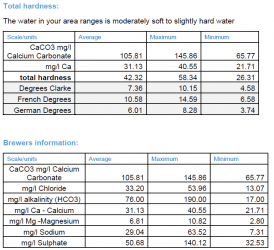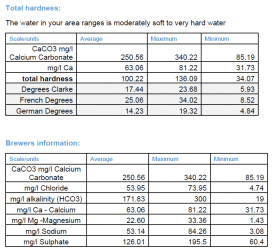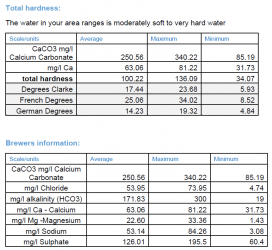do you have any limestone in the tank? It might raise the gh and kh somewhat
-
Guest, the Tank of the Year contest is underway!
💧 Which tank will win? 👉 View the entries and vote now!!
You are using an out of date browser. It may not display this or other websites correctly.
You should upgrade or use an alternative browser.
You should upgrade or use an alternative browser.
Why is my KH pH and GH increasing?
- Thread starter sparkypenguin
- Start date
I find it harder to soften water than harden water , you could add botanicals like almond leaves or elder cones to try and soften it .
Unless you’re prepared to start a RO system I don’t know how you can consistently soften the water , maybe the change is due to less rain fall meaning water is not being diluted as much and hardening . Just a theory
you can use an electronic descaler for intake copper pipes or a magnet for pvc pipes...both side by side...
sparkypenguin
Fish Fanatic
I have used the same test kit throughout (NTL test tube kit) and the last test I double checked with an API test tube kit so I don't think it's that but I will do as you suggest and take it to my LFS and see what they get.There doesn't appear to be anything in the aquarium that should change the pH, GH and KH. So it's either the water supply has changed or the test kits are faulty.
Take a sample of tap water and tank water to a pet shop and get them to test it. Take your test kits too and test the same water at the same time. Write the results down when they do the tests. If you get different readings to the shop, then one of the test kits is dodgy.
sparkypenguin
Fish Fanatic
Nope, some slate but very little and it has always been in.do you have any limestone in the tank? It might raise the gh and kh somewhat
sparkypenguin
Fish Fanatic
So I spoke to the water people and I am awaiting a call back within the week, however I have now found the latest water report for 2021 and this is what I found...
The 2020 water was on average 6.01 dH and within a range of 3.74 to 8.28 where as the 2021 results was on average 14.23 and within a range of 4.84 to 19.32.
Hence the average and max have more than doubled!
You would have thought that such increases would have had to be communicated to the end user but obviously not.
So although this does not explain why I did not see any significant increases changes in my dH until around May 2022 , it certainly provides food for thought.
It also raises the question as to how do fish keepers allow for an allowable tap water variation of between 4.84 and 19.32 dH?
If anyone is interested in the full water reports I could / may have uploaded them and maybe it would be worth having a section on the forum for water reports, past and present?
The 2020 water was on average 6.01 dH and within a range of 3.74 to 8.28 where as the 2021 results was on average 14.23 and within a range of 4.84 to 19.32.
Hence the average and max have more than doubled!
You would have thought that such increases would have had to be communicated to the end user but obviously not.
So although this does not explain why I did not see any significant increases changes in my dH until around May 2022 , it certainly provides food for thought.
It also raises the question as to how do fish keepers allow for an allowable tap water variation of between 4.84 and 19.32 dH?
If anyone is interested in the full water reports I could / may have uploaded them and maybe it would be worth having a section on the forum for water reports, past and present?
Attachments
How much limestone do you think ide need for a 200l drum ?I assume it’s the same , bring the water down to nothing so to say then add the minerals , I know a lot of saltwater setups use RO for that exact reason to make the water exactly how it’s needed , but for a fresh water set up I’d just get a 200l drum fill it with crush coral , shells anything you can find at the beach fill it with water and after a week it’s going to be liquid rock and you can repeat that every water change without messing around with minerals and RO
I’d do a small test in a 2l bottle first as I’m not really sure iv never needed to increase my Gh but for 200l I’d probably be looking at 30-40kg im guessing it’s trail an error until you achieve the ppm your afterHow much limestone do you think ide need for a 200l drum ?
Okay so work out how much it takes for a 2l bottle then just increase is in ratio with a bigger barrel?I’d do a small test in a 2l bottle first as I’m not really sure iv never needed to increase my Gh but for 200l I’d probably be looking at 30-40kg im guessing it’s trail an error until you achieve the ppm your after
They don'tIt also raises the question as to how do fish keepers allow for an allowable tap water variation of between 4.84 and 19.32 dH?
Water companies provide water for people to drink, not for fish. The only thing you can do is adjust the water before you use it. For soft water species, this might mean getting a reverse osmosis unit to remove the minerals from the water. Otherwise you can get rid of the soft water fishes and go for hard water fishes. Not a good option either way.
You may want to test your tap water just before water changes to be certain of what’s going into your tank. If you see variations in parameters- problem solved. I have had a similar problem with rising Gh/Kh values in a tank where nothing was supposed to increase either value, but I learned that the supposed inert substrate was the culprit. I simply placed some of the substrate in a bucket with water which was tested before and after two weeks. Both Gh and Kh values were higher.
That would be my planOkay so work out how much it takes for a 2l bottle then just increase is in ratio with a bigger barrel?
Awesome, I’ll give it a goThat would be my plan
TwoTankAmin
Fish Maniac
I actually change my water parameters in one tank. I drop my tap from neutral to 6.0 and the TDS from the mid 80s ppm to as close to the low 50s as I can. Changing one's water paramters is not so easy, especially when the direction is lowering the numbers. While ph/KH/GH are intertwined, it is the KH which is most important here.
KH is also called temporary hardness and it is somewhat easy to change. Most of the KH in tanks comes from carbonates and bicarbonates. Think of KH as being a sponge which absorbs acids. Acids are what lower the pH. So the higher one's KH, the harder it is to lower pH.
My first instinct was to ask about the substrate but you posted it was inert. If this is not actually the case then the testing above will reveal that. But there are other things that can cause a spike you are seeing. One is that water companies often mess with the pH to protect the pipes in the distribution system. The will raise GH/KH temporarily during treatment and then these are supposed to get dropped back to the more normal range. This doesn't always happen.
The other thing I would be curious about are the plants in the tank. If they are live, what ferts do you use if any.
One of thebiggest helps for you may be to learn a bit more about water chenistry. To that end I suggest you have a read here https://fins.actwin.com/mirror/begin-chem.html It has a section on altering parameters.
KH is also called temporary hardness and it is somewhat easy to change. Most of the KH in tanks comes from carbonates and bicarbonates. Think of KH as being a sponge which absorbs acids. Acids are what lower the pH. So the higher one's KH, the harder it is to lower pH.
My first instinct was to ask about the substrate but you posted it was inert. If this is not actually the case then the testing above will reveal that. But there are other things that can cause a spike you are seeing. One is that water companies often mess with the pH to protect the pipes in the distribution system. The will raise GH/KH temporarily during treatment and then these are supposed to get dropped back to the more normal range. This doesn't always happen.
The other thing I would be curious about are the plants in the tank. If they are live, what ferts do you use if any.
One of thebiggest helps for you may be to learn a bit more about water chenistry. To that end I suggest you have a read here https://fins.actwin.com/mirror/begin-chem.html It has a section on altering parameters.
Similar threads
- Replies
- 4
- Views
- 2K
Most reactions
-
 356
356 -
 154
154 -
 143
143 -
 141
141 -
 134
134 -
 134
134 -
 119
119 -
 108
108 -
 75
75 -
 70
70 -
 58
58 -
 57
57 -
 47
47 -
 45
45 -
F
44





